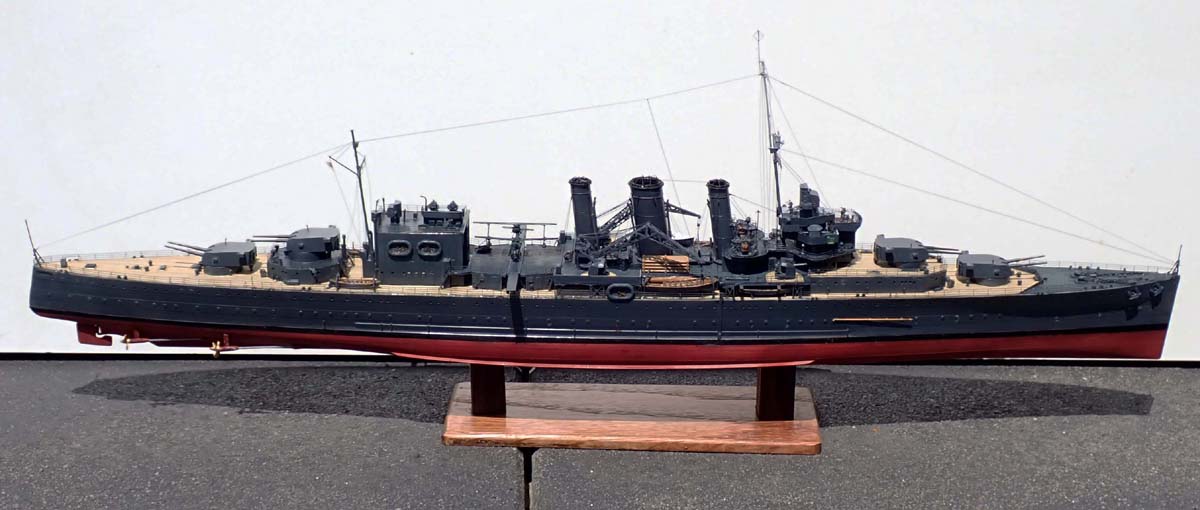
1/350 HMS Cornwall 1941 (Trumpeter)
|
by Robert Apfelzweig |

1/350 HMS Cornwall 1941 (Trumpeter)
Trumpeter’s HMS Cornwall is one of the first of its “County” class heavy cruiser model kits in 1/350. The kit is generally quite good, with an excellent fit of the single flush deck to the one-piece full hull; the only significant inaccurate feature, it would seem, is the waffle-type watertight doors molded into the superstructure parts, which, according to the instructions in White Ensign Models’s mostly excellent brass photoetch set, were not featured in British warships until later in World War II (their set provides more than enough correct replacements to show the doors either open or shut).One major problem with the photoetch set is the framing of the catapult; although it assembles quite nicely, in order to fit it into place, the boat deck must be cut apart to produce a rectangular gap, removing the molded plastic catapult, with the assembled brass catapult inserted between the two plastic deck sections. Unfortunately, the framing parts of the assembled catapult widen the gap so that the two deck sections cannot be positioned properly – or, at least, the rear portion with the aircraft hangar. This is especially obvious when installing the Chuanyu wooden deck (which has an excellent fit), leaving plastic deck gaps where the hangar section is shifted aft by several millimeters, and I had to cut away the bottoms of the interior plastic bulkheads facing the catapult in order for the brass framing to fit between and partly beneath them. The extended ends of the catapult, which would ordinarily be retracted into the catapult center, won’t fit that way, so it was either display them fully extended (as if to launch the Supermarine Walrus floatplane) or don’t display them at all. Another issue is that there is not enough railing for the midships areas where the boats and motor launches are stowed; I used spare material from my recent HMS Queen Elizabeth build. One minor quibble with the photoetch set generally is that there are, in my opinion, too many attachments points, especially for the numerous small parts, though the 3D rendering is very good. HMS Cornwall, portrayed in her late 1941 dark grey (507A) paint scheme, did not carry radar, but if modeling other, similar county class cruisers that did (e.g., HMS Berwick), White Ensign provides photoetch radar antennae for the foremast and the bridge rangefinder.
That dark grey paint was MasterModel acrylic; I used Tamiya Hull Red for the lower hull, and Tamiya Field Blue for the steel decks. Rigging is from stretched black sprue. Gun barrels (brass, 8-in. and 4-in.) were from Model Master; the two Vickers quad .50 cal. AA guns were from Black Cat Models.
Interestingly, a similar photoetch set from Eduard has several marked differences from White Ensign’s set, particularly textured steel platforms for the twin 4-in. gun mounts, whereas the wood deck includes wooden platforms. I’ll leave it to Royal Navy specialists as to which system was appropriate for the period (late 1941) depicted in my model.
Designed and built in the mid-1920s as a 10,000 ton “treaty cruiser” and given a major refit in 1936-37, HMS Cornwall saw extensive service early in World War II in the South Atlantic, eastern Mediterranean and Indian Oceans. On April 5, 1942 she and sistership HMS Dorsetshire were caught 200 miles/320 km south of Ceylon (Sri Lanka) by a squadron of Japanese Val dive bombers from three different aircraft carriers and sunk, with a combined loss of 424 men killed.
